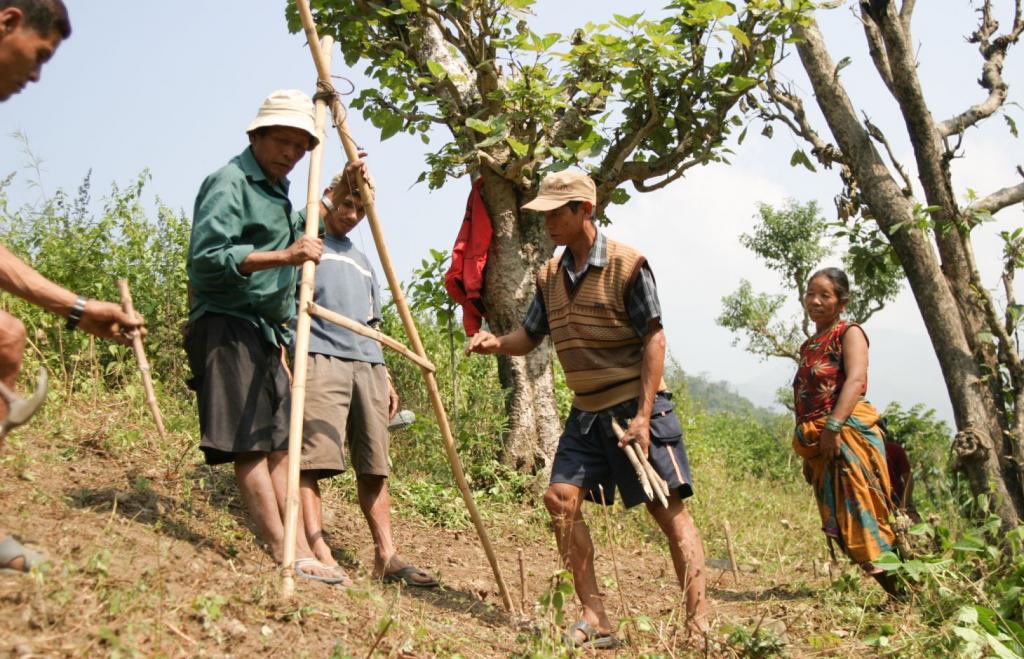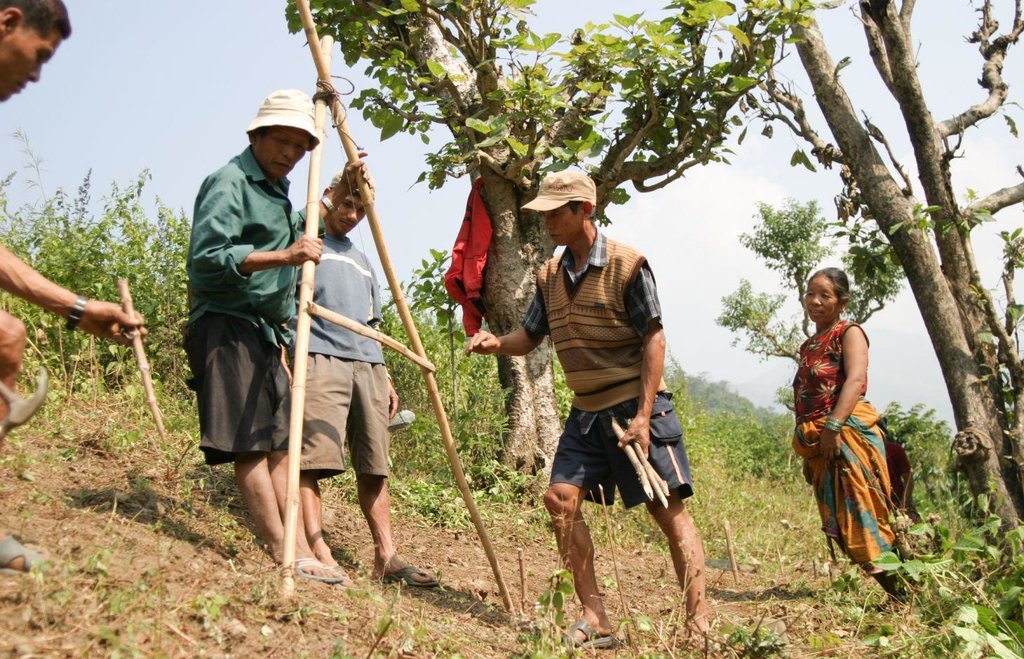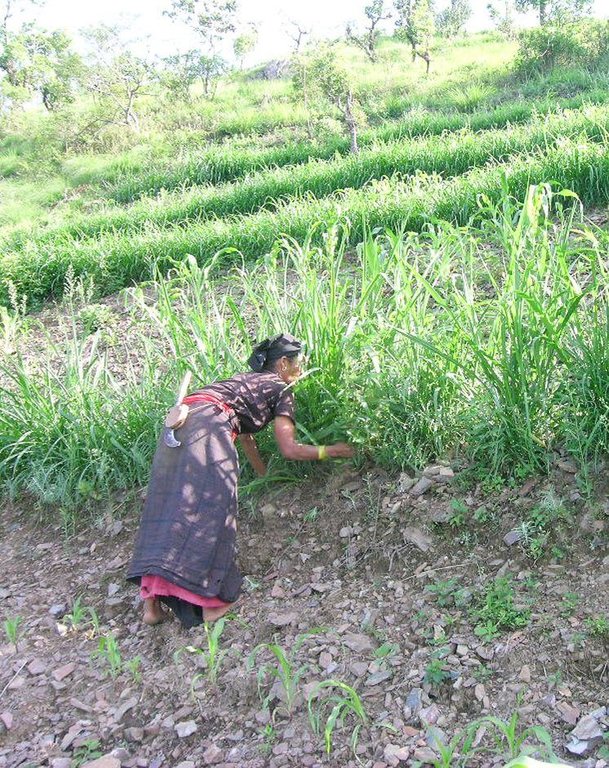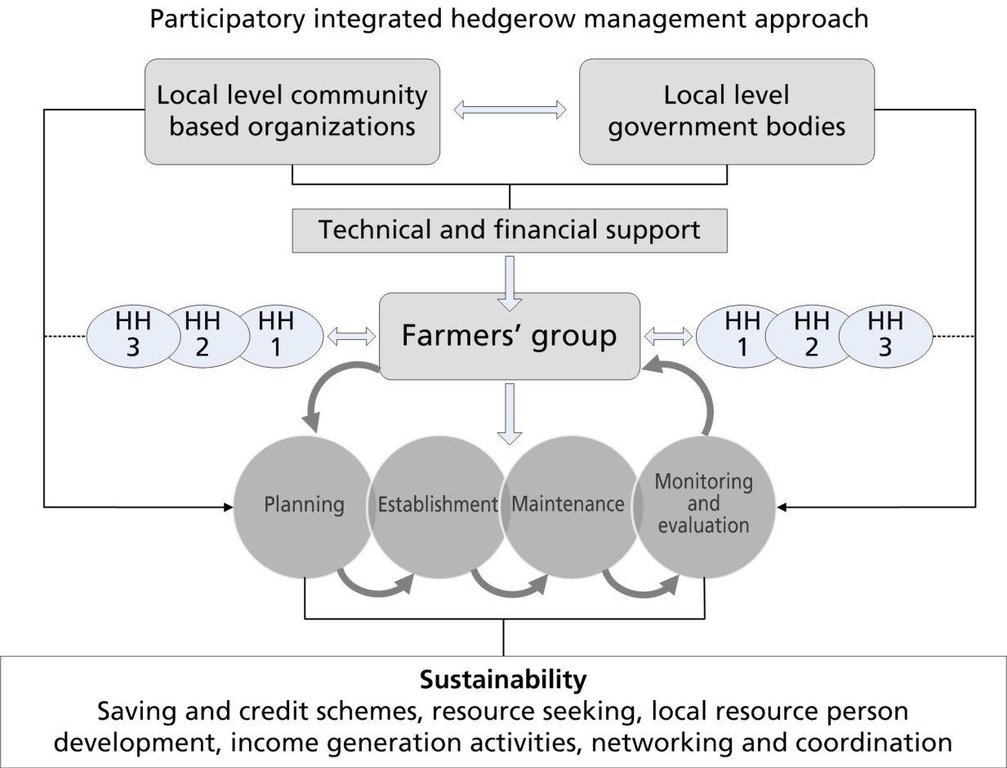Participatory hedgerow management [Nepal]
- Creation:
- Update:
- Compiler: Shreedip Sigdel
- Editor: –
- Reviewer: Fabian Ottiger
Sahabhagitamulak ghasehar bewasthapan (Main Contributor: Gyanbandhu Sharma, LI-BIRD)
approaches_2530 - Nepal
View sections
Expand all Collapse all1. General information
1.2 Contact details of resource persons and institutions involved in the assessment and documentation of the Approach
SLM specialist:
Name of the institution(s) which facilitated the documentation/ evaluation of the Approach (if relevant)
Local Initiatives for Biodiversity, Research, and Development (LI-BIRD) - NepalName of the institution(s) which facilitated the documentation/ evaluation of the Approach (if relevant)
ICIMOD International Centre for Integrated Mountain Development (ICIMOD) - Nepal1.3 Conditions regarding the use of data documented through WOCAT
When were the data compiled (in the field)?
01/03/2013
The compiler and key resource person(s) accept the conditions regarding the use of data documented through WOCAT:
Ja
1.4 Reference(s) to Questionnaire(s) on SLM Technologies

Hedgerow technology [Nepal]
A technology that uses hedgerows to help establish terraces on sloping land; farmers learn improved methods to manage a cultivation practice that stabilizes the soil, enhances food production, and adds to on-farm cash income.
- Compiler: Shreedip Sigdel
2. Description of the SLM Approach
2.1 Short description of the Approach
Hedgerow technology can be introduced through the joint participation of farmers, scientists, and related stakeholders. The whole community works together at all stages, including designing, planning, implementation, monitoring and evaluation, and scaling up.
2.2 Detailed description of the Approach
Detailed description of the Approach:
Aims / objectives: Communities can establish better hedgerows by supplementing the traditional knowledge that they have employed for generations with scientific knowledge through a participatory process where both groups are involved in every step of planning, designing, and implementation. This approach recognizes the validity of the local knowledge that farmers have about their land and supplements it with scientific techniques to facilitate the implementation of methods which will yield better results sooner.
Methods: Hedgerow technology can be implemented by forming farmers' groups and using a participatory approach. This technology has the potential to be scaled up and applied on a broader scale. The steps for sharing labour and know-how to establish hedgerows can be summarized as follows:
• Capacity is strengthened through discussions with technical persons.
• Farmers, technical persons, and related stakeholders work together to come up with plans that make the best use of both the farmers’ indigenous knowledge on how to form hedgerows and their understanding of the landscape, and scientific knowledge, for designing and planning.
• The hedgerows are established by the farmers as per the consensual plan.
• Some farmers are designated to periodically inspect the hedgerows and to perform maintenance as needed.
• The technology is scaled up by farmers who disseminate the learning to other farmers through extension and knowledge sharing at different fora.
Stages of implementation: Farmers, technical persons, and related stakeholders were all involved at every stage. In addition, LI-BIRD, local community-based organizations, and other related stakeholders such as the district forest office and the district agriculture office were on hand to support the farmers' group by offering technical and financial resources. The farmers' groups had a vested interest in this approach and demonstrated their commitment by: generating funds from a savings and credit scheme and conducting income generating activities. They also worked to establish effective linkages and to coordinate with related stakeholders to obtain resources which would ensure that the group would be self-reliant in the long run. The involvement of a wide range of participants will ensure that the technology is not only effective but that it is also sustainable. Moreover, when neighbouring communities see how successful this approach can be, it is hoped that they also will adopt the technology.
2.3 Photos of the Approach
2.5 Country/ region/ locations where the Approach has been applied
Country:
Nepal
Further specification of location:
Gorkha, Tanahu District
2.7 Type of Approach
- project/ programme based
2.8 Main aims/ objectives of the Approach
The Approach focused mainly on SLM with other activities (Income generation)
The objective of this approach was to introduce the technology through participatory planning, designing, and implementation by integrating farmers’ knowledge and experiences in the process.
The SLM Approach addressed the following problems: This approach addressed a few of the major problems in the area. The outstanding problems were:
• poor technical knowledge,
• lack of group efforts,
• lack of cash for investment,
• poor access to service providers,
• inadequate use made of farmers' traditional knowledge,
• inadequate knowledge resources, and
• poverty and poor social cohesiveness.
2.9 Conditions enabling or hindering implementation of the Technology/ Technologies applied under the Approach
availability/ access to financial resources and services
- hindering
Farmers had insufficient financial resources to implement the technology
Treatment through the SLM Approach: Farmers learned how to apply for resources from different related stakeholders and they also learned how to generate cash from their own group using savings and credit schemes.
institutional setting
- hindering
Farmers had no formal institutional mechanisms and also had no capacity to run their institutions
Treatment through the SLM Approach: Farmers learned how to form a formal group and also improved their capacity to run their institutions
legal framework (land tenure, land and water use rights)
- hindering
The existing land ownership, land use rights / water rights hindered a little the approach implementation
knowledge about SLM, access to technical support
- hindering
Farmers had low technical knowledge
Treatment through the SLM Approach: Farmers shared their know-how and also learned from scientists, other farmers and related stakeholders
3. Participation and roles of stakeholders involved
3.1 Stakeholders involved in the Approach and their roles
- local land users/ local communities
- SLM specialists/ agricultural advisers
- NGO
LI-BIRD
- local government
- national government (planners, decision-makers)
If several stakeholders were involved, indicate lead agency:
Specialists and land users. During the design process, specialists organized on-farm visits and exposure visits. The plan was prepared jointly by the land users and the specialists who used each others' expertise.
3.2 Involvement of local land users/ local communities in the different phases of the Approach
| Involvement of local land users/ local communities | Specify who was involved and describe activities | |
|---|---|---|
| initiation/ motivation | passive | At the beginning, the land users were mostly passive because they lacked information on sloping land management. |
| planning | interactive | Land users were actively involved in the planning stage and they incorporated feedback from other stakeholders to finalize the action plan. During this phase they also prepared the land and the materials, and recruited the resource person needed to implement the technology |
| implementation | self-mobilization | Land users were involved in the implementation phase mobilizing their group members and shared the new technical knowledge that they had acquired. |
| monitoring/ evaluation | interactive | Land users and other stakeholders remained actively involved throughout the different stages of monitoring and evaluation. |
| Research | external support | Land users were actively involved in research work to test and validate the approach. |
3.3 Flow chart (if available)
3.4 Decision-making on the selection of SLM Technology/ Technologies
Specify who decided on the selection of the Technology/ Technologies to be implemented:
- mainly land users, supported by SLM specialists
Explain:
Both farmers and specialist were involved in on-farm visits to assess the condition of the land; farmers attended seminars to acquire new knowledge and they also used this opportunity to share their own knowledge. Farmers and specialists together selected the technology.
Decisions on the method of implementing the SLM Technology were made by mainly by land users supported by SLM specialists
4. Technical support, capacity building, and knowledge management
4.1 Capacity building/ training
Was training provided to land users/ other stakeholders?
Ja
Specify who was trained:
- land users
- field staff/ advisers
- Local Resource Person
Form of training:
- farmer-to-farmer
- demonstration areas
Subjects covered:
This approach provided training on hedgerow technology and group mobilization to enhance the capacity of land users, field staff, and local resource persons. Site visits to the demonstration areas were also organized for the land users.
4.2 Advisory service
Do land users have access to an advisory service?
Ja
Specify whether advisory service is provided:
- at permanent centres
Describe/ comments:
Name of method used for advisory service: Group Mobilization Method; Key elements: networking and coordination of farmers' groups with district level line agencies such as the district forest office, the district agriculture office, the district livestock office, and other relevant stakeholders for learning and sharing of information.
4.3 Institution strengthening (organizational development)
Have institutions been established or strengthened through the Approach?
- yes, a little
Specify the level(s) at which institutions have been strengthened or established:
- local
Specify type of support:
- capacity building/ training
Give further details:
Trainings and sessions on capacity building were provided to the land users
4.4 Monitoring and evaluation
Is monitoring and evaluation part of the Approach?
Ja
Comments:
bio-physical aspects were regular monitored by project staff, land users through observations; indicators: The land users and project staff made regular observations of sediment deposition rates after the intervention.
technical aspects were regular monitored by project staff, land users through observations; indicators: The land users and project staff made regular observations on the formation of terraces and control of erosion.
socio-cultural aspects were regular monitored by project staff, land users through observations; indicators: The land users and project staff regularly observed sociocultural impacts
economic / production aspects were regular monitored by project staff, land users through observations; indicators: The land users and project staff regularly observed the extent to which the income of the land users changed.
area treated aspects were regular monitored by government, land users through measurements; indicators: The land users and government staff monitored the coverage of the technology.
no. of land users involved aspects were regular monitored by project staff, land users through observations; indicators: Regular observations were made by the land users and project staff on how many land users were adopting the technology.
management of Approach aspects were regular monitored by project staff, land users through observations; indicators: The land users and project staff regularly observed how well the group functioned together and how well they linked with stakeholders
There were few changes in the Approach as a result of monitoring and evaluation: Monitoring brought few changes; farmers used the information gathered during monitoring of on-farm demonstration to help them select the species they preferred but the technology remained the same.
There were no changes in the Technology as a result of monitoring and evaluation
4.5 Research
Was research part of the Approach?
Ja
Specify topics:
- technology
Give further details and indicate who did the research:
On-farm technical research was a part of the approach applied by land users, specialists, and relevant stakeholders who were involved in hedgerow technology trials.
Research was carried out on-farm
5. Financing and external material support
5.1 Annual budget for the SLM component of the Approach
Comments (e.g. main sources of funding/ major donors):
Approach costs were met by the following donors: national non-government: 20.0%; local government (district, county, municipality, village etc): 10.0%; local community / land user(s): 70.0%
5.2 Financial/ material support provided to land users
Did land users receive financial/ material support for implementing the Technology/ Technologies?
Ja
If yes, specify type(s) of support, conditions, and provider(s):
LI-BIRD provided some support.
5.3 Subsidies for specific inputs (including labour)
If labour by land users was a substantial input, was it:
- voluntary
5.4 Credit
Was credit provided under the Approach for SLM activities?
Nee
6. Impact analysis and concluding statements
6.1 Impacts of the Approach
Did the Approach help land users to implement and maintain SLM Technologies?
- No
- Yes, little
- Yes, moderately
- Yes, greatly
This approach helped to stabilize the fragile hill slopes.
Did the Approach empower socially and economically disadvantaged groups?
- No
- Yes, little
- Yes, moderately
- Yes, greatly
The capacity of marginal ethnic groups increased; they learned how local institutions function and felt empowered to seek resources from their service providers.
Did other land users / projects adopt the Approach?
- No
- Yes, little
- Yes, moderately
- Yes, greatly
This approach was adopted by adjoining villagers and scaled up gradually in Dhading, Chitwan, Nawalparasi, and Makwanpur Districts. According to preliminary information, at least 450 households have now adopted this approach for sustainable land management.
Did the Approach lead to improved livelihoods / human well-being?
- No
- Yes, little
- Yes, moderately
- Yes, greatly
This approach helped to improve the livelihood status of the land users by helping to diversify their options for income generation and skills development.
Did the Approach help to alleviate poverty?
- No
- Yes, little
- Yes, moderately
- Yes, greatly
After the implementation of this approach, land users could earn cash income and learned how to increase their capacity to implement income generating activities which would enhance their livelihoods.
6.2 Main motivation of land users to implement SLM
6.3 Sustainability of Approach activities
Can the land users sustain what has been implemented through the Approach (without external support)?
- uncertain
If no or uncertain, specify and comment:
Individual land users were enthusiastic to implement the approach and to take it further. Land users who are shifting cultivators, and who typically have no land ownership, are slower to embrace the approach.
6.4 Strengths/ advantages of the Approach
| Strengths/ advantages/ opportunities in the compiler’s or other key resource person’s view |
|---|
| Sustained capacity building (How to sustain/ enhance this strength: Continue to build strong links and coordinate with government line agencies) |
| Improved access to services providers helped to enhance their capacity to cope with adverse conditions (How to sustain/ enhance this strength: Continue to build and maintain contact with government line agencies) |
| Local institutions were strengthened (How to sustain/ enhance this strength: Established formal institutions and help to sustain them) |
| Land users actively participated and took ownership (How to sustain/ enhance this strength: Continue capacity building and training. At present the government is initiating programmes with leasehold forest groups in Gorkha and Tanahu Districts that encourages the establishment hedgerows è Work to mainstream the approach within government programmes) |
| Collaboration helped land users to sustain their efforts (How to sustain/ enhance this strength: Continue to build a sense of community between land users) |
6.5 Weaknesses/ disadvantages of the Approach and ways of overcoming them
| Weaknesses/ disadvantages/ risks in the compiler’s or other key resource person’s view | How can they be overcome? |
|---|---|
| Difficult to develop common understanding | Organized regular learning and sharing to develop common understanding |
|
Farmers have only a limited understanding of the skills needed |
Continue to strengthen farmers' groups and continue to mobilize through sharing and learning |
| The approach is resource intensive. | Promote savings and credit schemes with farmers' groups. Mobilize farmers' groups so that they can petition other groups and line agencies for resources. |
| Time consuming | Work with land users to improve their time management and their ability to plan future activities and delegate responsibilities |
| Few farmers participated during the initial stages | Conduct awareness raising activities and promote activities that give some tangible benefits in the short term. |
7. References and links
7.1 Methods/ sources of information
- field visits, field surveys
- interviews with land users
7.2 References to available publications
Title, author, year, ISBN:
Building on partnership approaches in participatory identification of integrated agricultural technological packages suitable for sloping land areas (unpublished), Regmi, BR; Aryal, KP; Shrestha, PK; Tamang, BB (2003)
Available from where? Costs?
LI-BIRD
Links and modules
Expand all Collapse allLinks

Hedgerow technology [Nepal]
A technology that uses hedgerows to help establish terraces on sloping land; farmers learn improved methods to manage a cultivation practice that stabilizes the soil, enhances food production, and adds to on-farm cash income.
- Compiler: Shreedip Sigdel
Modules
No modules






